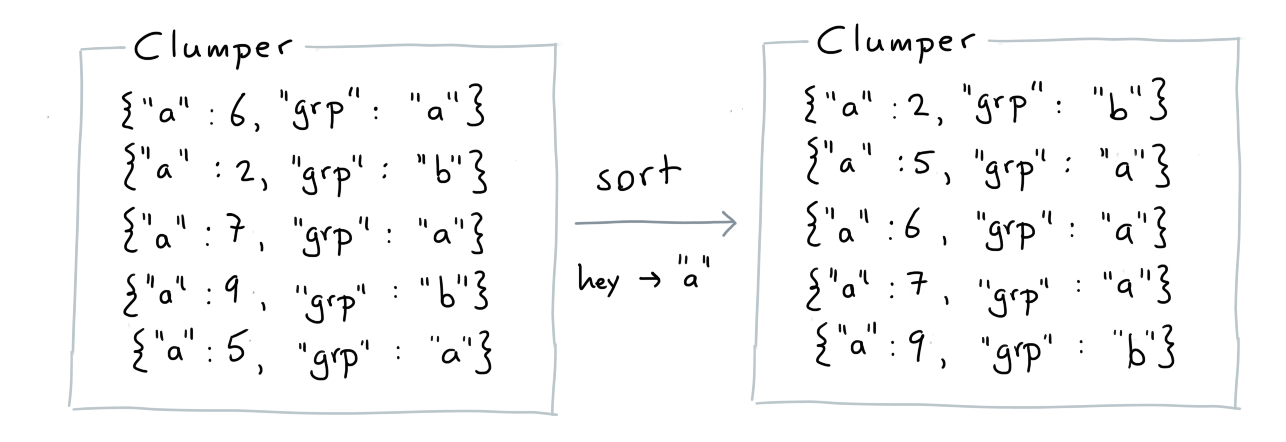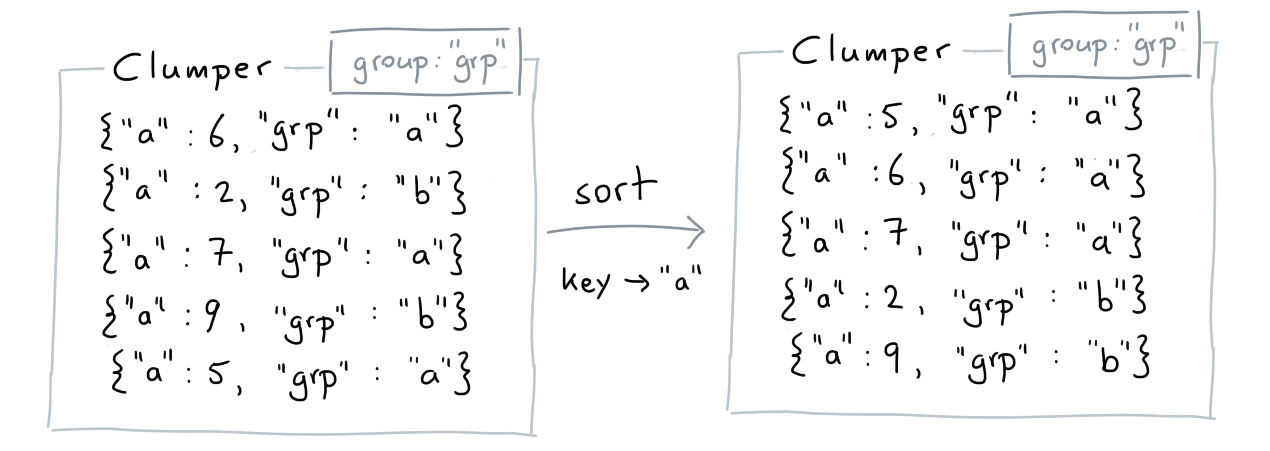About Groups
If a group is present on a Clumper then the behavior
of some of the verbs will change. This guide will explain
what changes you can expect and why they are useful.
What is a Group?¶
You can add a group to a Clumper by calling .group_by().
from clumper import Clumper
list_dicts = [
{'a': 6, 'grp': 'a'},
{'a': 2, 'grp': 'b'},
{'a': 7, 'grp': 'a'},
{'a': 4, 'grp': 'b'},
{'a': 5, 'grp': 'a'}
]
(Clumper(list_dicts)
.group_by('grp'))
The current group is now looking at all the items that have grp as a key.

This means that the collection is now aware that you're interested
in calculating things per group. In this case you'd get two groups. One for
{'grp': 'a'} and one for {'grp': 'b'}.
There are some verbs that will behave differently because of this.
Agg¶
Without Groups¶
When you don't have a group active then we'll make a single summary for the entire collection of items.

from clumper import Clumper
list_dicts = [
{'a': 6, 'grp': 'a'},
{'a': 2, 'grp': 'b'},
{'a': 7, 'grp': 'a'},
{'a': 4, 'grp': 'b'},
{'a': 5, 'grp': 'a'}
]
(Clumper(list_dicts)
.agg(s=('a', 'sum'),
m=('a', 'mean'))
.collect())
With Groups¶
When there is a group active then we'll make a summary per group. We'll also ensure that the keys of the relevant groups are made available in the new collection.
Note that the group is still active!

from clumper import Clumper
list_dicts = [
{'a': 6, 'grp': 'a'},
{'a': 2, 'grp': 'b'},
{'a': 7, 'grp': 'a'},
{'a': 4, 'grp': 'b'},
{'a': 5, 'grp': 'a'}
]
(Clumper(list_dicts)
.group_by('grp')
.agg(s=('a', 'sum'),
m=('a', 'mean'))
.collect())
Aggergators¶
You can use your own functions if you want to do aggregation but we offer a few standard ones. Here's the standard mapping.
{
"mean": mean,
"count": lambda d: len(d),
"unique": lambda d: list(set(d)),
"n_unique": lambda d: len(set(d)),
"sum": sum,
"min": min,
"max": max,
"median": median,
"var": variance,
"std": stdev,
"values": lambda d: d,
"first": lambda d: d[0],
"last": lambda d: d[-1],
}
Transform¶
The .transform() verb is similar to the .agg() verb. The main difference is
that it does not reduce any rows/keys during aggregation. Instead they are merged
back in with the original collection. The examples below should help explain what
the usecase is.
Without Groups¶
With no groups active we just attach the same summary to every item.

from clumper import Clumper
data = [
{"a": 6, "grp": "a"},
{"a": 2, "grp": "b"},
{"a": 7, "grp": "a"},
{"a": 9, "grp": "b"},
{"a": 5, "grp": "a"}
]
tfm_data = (Clumper(data)
.group_by("grp")
.transform(s=("a", "sum"),
u=("a", "unique"))
.collect())
With Groups¶
With groups active we calculate a summary per group and only attach the relevant summary to each item.

from clumper import Clumper
data = [
{"a": 6, "grp": "a"},
{"a": 2, "grp": "b"},
{"a": 7, "grp": "a"},
{"a": 9, "grp": "b"},
{"a": 5, "grp": "a"}
]
tfm_data = (Clumper(data)
.group_by("grp")
.transform(s=("a", "sum"),
u=("a", "unique"))
.collect())
Mutate¶
This library offers stateful functions like row_number. If you use
these functions while there is a group active you'll notice different
behavior.
Without Groups¶
When there is no group we just start counting at one and we continue counting until we're at the end of the collection.

from clumper import Clumper
from clumper.sequence import row_number
list_dicts = [
{'a': 6, 'grp': 'a'},
{'a': 2, 'grp': 'b'},
{'a': 7, 'grp': 'a'},
{'a': 4, 'grp': 'b'},
{'a': 5, 'grp': 'a'}
]
(Clumper(list_dicts)
.mutate(r=row_number())
.collect())
With Groups¶
Because there are groups you'll notice that the order
is different but also that the row_number resets when
seeing the new group.

from clumper import Clumper
from clumper.sequence import row_number
list_dicts = [
{'a': 6, 'grp': 'a'},
{'a': 2, 'grp': 'b'},
{'a': 7, 'grp': 'a'},
{'a': 4, 'grp': 'b'},
{'a': 5, 'grp': 'a'}
]
(Clumper(list_dicts)
.group_by('grp')
.mutate(r=row_number())
.collect())
Sort¶
Without Groups¶
With no groups active, we just sort the entire collection
based on the key that is provided.

from clumper import Clumper
list_dicts = [
{'a': 6, 'grp': 'a'},
{'a': 2, 'grp': 'b'},
{'a': 7, 'grp': 'a'},
{'a': 9, 'grp': 'b'},
{'a': 5, 'grp': 'a'}
]
(Clumper(list_dicts)
.sort(key=lambda d: d['a'])
.collect())
With Groups¶
With groups active, still perform the sorting but only within each group.

from clumper import Clumper
list_dicts = [
{'a': 6, 'grp': 'a'},
{'a': 2, 'grp': 'b'},
{'a': 7, 'grp': 'a'},
{'a': 9, 'grp': 'b'},
{'a': 5, 'grp': 'a'}
]
(Clumper(list_dicts)
.group_by('grp')
.sort(key=lambda d: d['a'])
.collect())
Ungroup¶
If you're done with a group and you'd like to move on you can drop all
groups by calling .ungroup().